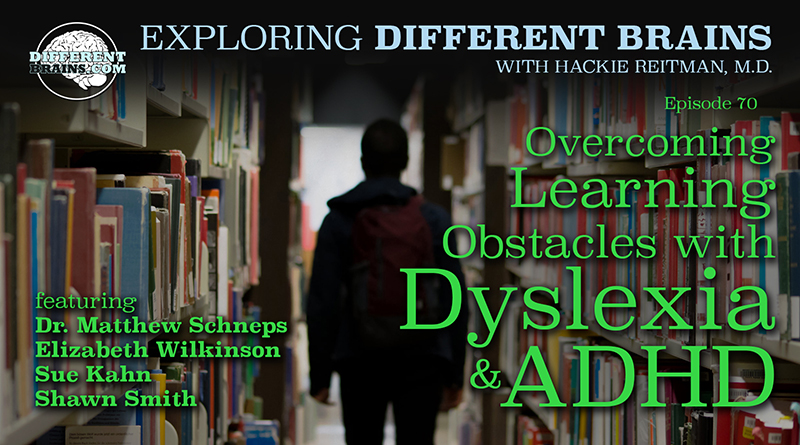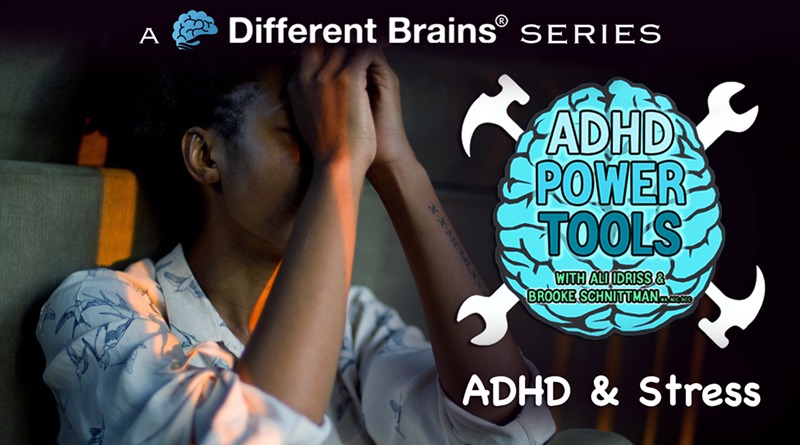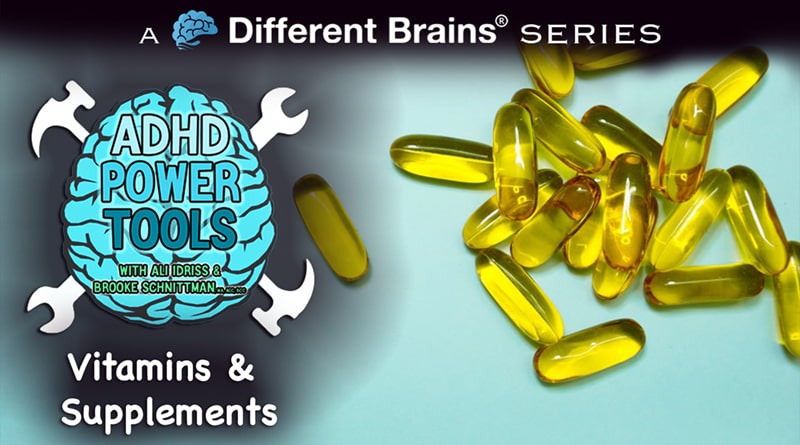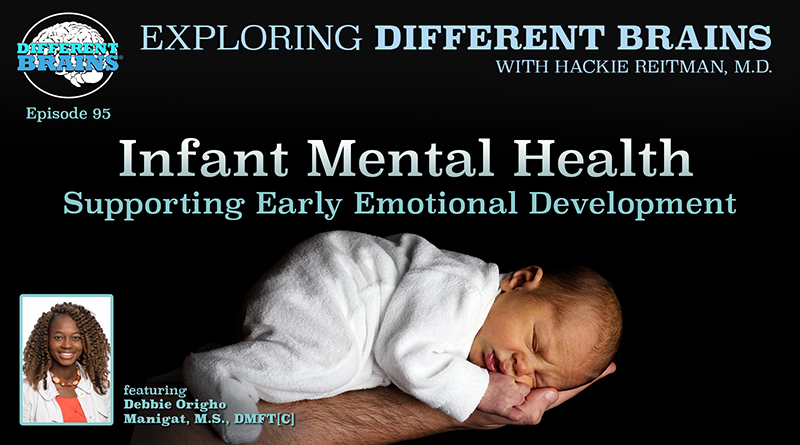
Overcoming Learning Obstacles with Dyslexia & ADHD | EDB 70
In this special episode of Exploring Different Brains, Hackie Reitman, M.D. presents 4 previous guests as they discuss ways to overcome the learning challenges presented by dyslexia and ADHD. Guests include: Dr. Matthew Schneps (an astrophysicist and visiting scientist at M.I.T., and founder of the Laboratory for Visual Learning), Elizabeth Wilkinson (a British autism and dyslexia advocate known as The Dyslexic Dyslexia Consultant , and founder of Dyslexia Information Day), Sue Kahn (a dedicated educator and author of the “Sue’s Strategies” series, and the parent of a young man with dyslexia and ADHD), and Shawn Smith (a self-advocate, entrepreneur, innovator, counsellor and psychotherapist specializing in the emerging field of Neurodiversity, and founder and CEO of Don’t dis-my-ability consultation services Inc.).
For the full interview with Dr. Matthew Schneps, click here. For more information about Dr. Schneps and the Laboratory for Visual Learning, visit: labvislearn.org
For the full interview with Elizabeth Wilkinson, click here. For more information about Elizabeth’s work, visit www.theddc.org.uk
For the full interview with Sue Kahn, click here. To learn more about Sue and her books, please visit: www.SueKahnReadNow.com. Also, check out her YouTube channel for helpful educational videos: Sue’s YouTube Channel
For the full interview with Shawn Smith, click here. For more about Shawn and Don’t Dis-my-Ability, visit: www.ddmacs.ca. Also, check out the video blogs Shawn has contributed to this site: http://differentbrains.com/author/shawn-smith-m-ed-ccc/
46 Second Preview:
To listen or download the podcast version of this episode, see the embedded player below.
Or look for us on your favorite podcast provider:
iTunes | Stitcher | SoundCloud
[expand title=”View Full Transcript”]
HACKIE REITMAN, M.D. (HR)
Hello, I’m Dr Hackie Reitman, and welcome to another episode of Exploring Different Brains. On today’s special episode we’re going to look at two entities dyslexia and ADHD, and how these individuals overcome educational obstacles.
First, we’re going to hear from my friend Matthew Schneps, the brilliant astrophysicist at MIT who credits his amazing abilities to see the stars with his dyslexia.
HR
We have Matt Schneps. He’s an astrophysicist, a visiting scientist at MIT, the Massachusetts’s Institute of Technology, a founding member of the science education department at the Harvard Smithsonian Center for Astrophysics founded the laboratory for visual learning to carry out research and cognitive psychology to investigate how individual differences in neurology, including those associated with dyslexia, ADHD, and autism spectrum disorders affect how people learn science. He also, just as an extra value added, himself happens to be dyslexic. And so I’m honored to be talking today with Dr. Matthew Schneps. Matt, welcome! How are you?
MATTHEW SCHNEPS (MS)
Good, thank you, I’m honored as well, and just a quick correction on my very nice introduction you gave me, it’s not that I just happen to have dyslexia, it’s because of my dyslexia that I’ve done these things. So it’s a bit different.
HR
I would like you to repeat what you just said and expand upon it. What I heard you say is, the way my brain works, is that, Hackie, it’s not just that I happen to be into this and I happen to be dyslexic–I am into what I’m into precisely because I am dyslexic. Did I get that right?
MS
You got it 100% correct.
HR
Then tell us how it all began–this is fascinating. I may write a book about you.
MS
Well, how it all began–I mean that’s a very long story. How can we make it succinct–let me think for a second. I mean, at some level, I’ve ended up here because of accidents of career, right, I mean that happens to everybody. You think you’re going to do something in life and, you know, the ball bounces this way and that way and before you know it, you’re someplace different from where you thought you would be. And that’s very much the case with me. However, what makes me a little bit different is that I was always obsessively interested in certain things and I followed through on them. So, for example, when I was very young, I just loved astronomy, I mean I really did. I just thought everything astronomical was fascinating and very, very interesting and beautiful, and I kind of knew from the age of, I don’t know, seven, eight–whenever you’re kind of conscious of these kinds of things–that I wanted to be an astronomer. And so I spent the early part of my career just trying to become an astronomer, but you know how the accidents of these sport game go.
My attempts to go this way and that didn’t work, because I couldn’t do standardized test–there were I lot of things I couldn’t do. It was very disappointing to me, and I didn’t get to where I wanted to go, even though I was very good at the things I was doing, so I nevertheless kind of made it all the way up to MIT and got a PhD in astrophysics, but once I was there I realized there was a lot of stuff I just can’t do; I can’t read papers that I have to read–it’s really hard for me to go to meetings and sit in meetings–there are a lot of things that just made it difficult for me to keep going as an astronomer, so rather than feeling bad about myself, which is what often happens when you’re sort of kicked into a corner and you don’t know what to do, I started to think, how–you know, what are the things that I’m good at? And how can I really maximize those things? And so I was very good at dealing with images, that’s why I loved astronomy, I was very good at telling stories–I decided I wanted to go into filmmaking, I did that–I started a group that created educational television programs for science learners, I then became very interested in how people learn, so I started looking at the neuroscience of those things and, you know, on and on and on, and that’s kind of how I ended up where I am, and it’s all because I was very curious about how my own brain worked. And also I followed the things I was interested in, and really tried to make the best use of the things that I was good at. I started ignoring what other people expected me to be good at, and I started focusing on the things that I’m good at. So that’s a very long-winded answer to your short question.
HR
Next we’re going to hear from Elizabeth Wilkinson from over there in England- or she’s better known across the pond: The Dyslexic Dyslexia Consultant.
ELIZABETH WILKINSON (EW)
Well, my mom had always thought that I was.
HR
Why? Why did she think you were dyslexic?
EW
I would imagine, she would say, because of the difference between my academic attainments and my IQ, vocabulary, interests, etc.
HR
So, in other words, you were pretty smart but you weren’t doing good in school.
EW
Yeah. I’ve got a mom with an IQ of 163 so I come from good stock.
HR
Wow. I can’t even count that high. Let’s talk about your brain from the vantage point of your first level dyslexia, because you are the Dyslexic Dyslexia Consultant.
EW
I am, I do want to say how meticulous the odd goes–I just–I work with dyslexics and I train people about dyslexia. But what I find is when I’m working with a dyslexic on a one-to-one or in a small group, if I–when I tell them I’m dyslexic, I can physically see them relax, because they’ve finally got somebody who will understand, or at least knows where they’re coming from. So you know that they get it. They get that I get it. And I also understand that, as you say, everybody’s different. So that always helps. And I like recycling undoers, you know, you say to somebody, “Try this idea,” but don’t just think you’ve got to use that idea in itself. You can change it and adapt it to suit yourself…
HR
So, you were diagnosed, and then what did you do, like what tips can you give our audience that–how you overcame the challenges?
EW
In all honesty, I did a course to find out about dyslexia because I thought my son was, and, from there, everything made sense. I knew the answers to questions, I understood the topics, I was getting good grades on my assignments because I understood the subject. So I, personally, had done a lot of research, had done a lot of reading around dyslexia, and I came across a book by Dr. Tilly Mortimore, who is my idol, I have to say, when it comes to dyslexia. And it was her first book about dyslexic learning styles that I learned about the three core deficits of dyslexia, so I learned about short-term memory difficulties, automatisty difficulties and phonological difficulties, and they made sense, and I understood about myself, so, for me, my advice to people is find out how something effects you and have that impact on your everyday life.
HR
Next we’re going to hear from Sue Kahn, the mother of a young man with ADHD and dyslexia. So what did this mother do? She created new learning techniques! Watch…
HR
Sue, you’ve had quite a history trying to help people with various disabilities going back to Texas. Why don’t you tell us about your career?
SUSAN KAHN, M.Ed. (SK)
Certainly. I became a teacher of–you know, just regular elementary school classrooms, and I taught a year after earning my Master’s Degree from Boston University in education, where I had majored in reading, and then I decided to have a family.
But my family turned out to be rather different from most people’s families because one son had a severe dyslexia, another son had a very rare physical ailment, which eventually took his life, and a third son had some mental health issues. So I became interested in my own self interest of helping my children in learning everything I possibly could about how the brain learned and how I was going to solve the problems of my children. And I succeeded best with my dyslexic child, and I’ve made it a career, and I’ve actually helped thousands of people. Now I’m trying to spread the knowledge with books, for parents and teachers, so that others will know how to help a dyslexic child read within one year.
HR
Tell us the name of the book.
SK
It’s Sue’s Strategies: Best Reading/Spelling Method Ages 6-60. I am certified at all levels of instruction, elementary, middle and senior high school, but I’ve also worked for mass rehab commission in Boston, so I’ve had experience with adults. And I believe the oldest person I’ve taught was 59 and he just celebrated his 60th birthday…
If a person’s dyslexia affects more than just being able to read the words–it affects the way he understands sentences, and usually, the person needs some retraining in how to understand sentences the way most people understand them. And then, once that knowledge of grammar, which is what I teach in this book, is solidly implanted in the dyslexic person’s head. Then, he begins to understand language as most of us do, and his fluency and comprehension both go up, as well as his writing skills improve dramatically because he’s not afraid to write long sentences, he knows that whatever he’s written is correct as long as he followed the rules in the book…
HR
Could you elaborate on your view–your macro-view of the brain and neurodiversity?
SK
Yes. Well my scope has been much narrower than yours, and I certainly admire you for all of the work that you’ve done, and I’m delighted to hear about your daughter–that’s just awesome. My son basically suffered from the ADHD and the dyslexia, and I was lucky enough, eventually, once I got over the hurdle of, “Oh my God, I’m going to put my son on meds,” to have a fabulous psych pharmacologist who understood my son so that his attention was there, and then the issue clearly was dyslexia–now Dr. Sally Shaywitz from Yale University Child Development Clinic, has been taking FMR pictures of dyslexic brains for approximately 30 years. So she can validate that the language cells for dyslexic people tend to be in the right hemisphere and not altogether.
So that it’s difficult for a dyslexic person to learn language when the left hemisphere is really geared for language acquisition and the right hemisphere isn’t–and then the language cells have to communicate with each other and there’s a distance so that slows down the speed. But, Dr. Orton had published the multi-sensory Orton Gillingham method of reading, prior to Dr. Sally Shaywitz’s brain research. And so she decided to give her patients, or clients, whatever one calls them–a one year of reading intervention with synthetic phonics, which is basically what Dr. Orton suggested, and it’s the method I use, although I’ve updated it with lots of memory tactics that we know about now that Dr. Orton didn‚Äôt know about then. So the result of the FMR follow-up studies was that the brain cells had migrated from the right hemisphere to the left hemisphere and suddenly, the dyslexic people found that their language problem had become so much better.
So what we’re trying to do now with intervention, I’m working on advocacy in Massachusetts, is to encourage our legislature to pass a couple of laws that would define dyslexia as a neurobiological disorder that affects language acquisition, to ask them to screen for dyslexia because Dr. Nadene Gabb at Children’s hospital in Boston has recently come up with a 20-minute screening test for five-year-olds that detects dyslexia with 92% accuracy, and then we want the schools to give early intervention with some evidence-based methods, like Dr. Orton’s and mine, that are geared especially for dyslexic students, so that they–the children are all reading on grade level or above before they start third grade, which is reading to learn. And this is all very doable. Now I cannot really teach everybody to read and write within one year, I usually keep students for two years–the first year to teach them the reading process, and the second year to teach them the writing process. But, we know that all of the synthetic phonetic programs succeed in making excellent readers out of the dyslexic children. So it’s very important for us to go state-by-state and just change the laws and give our children an opportunity to learn. So my view of the brain is not as broad as yours, I mean I also understand about different areas that affect learning, you know, the frontal lobes and the ADHD and the executive function, but my work has primarily been with the dyslexic language acquisition problem, and it’s in that way that I can help people the most.
HR
Finally we’re going to hear from Shawn Smith, who’s the Canadian advocate who himself overcame the challenges of undiagnosed ADHD to go on to help many.
SHAWN SMITH (SS)
I was undiagnosed with ADHD until age 30. It took me four years to finish three years of high school. 32 attempts during 18 credits required to graduate including failing grade 10 math four times. Trudging my way through and then started taking medication when I was diagnosed at age 30 and it gave my brain the jump start it needed and it kind of took my brain from dial up to fiber opt and I went from the bottom of the class to the top. Kind of battling my way through different social policies. I was disabled but not quite disabled enough. So I started challenging social policy and kind of just getting my bearings and realizing that when people say that the system is broken it implies that it was intended to work in the first place and the research that I’ve done shows explicitly that it’s not. So I’ve just kept battling and was finally, I got into the masters education and counseling psychology program at UNB. I was admitted on academic probation and I graduated less than a year later at the top of my class.
HR
You were a young, young little kid of 24 years old when you learned how to count.
SS
Yeah, I used to go around with pocket change and I couldn’t count it. There could be any type of stimuli lights or sound and that’s being part of neurodiverse that we feel and sense things more deeply than others. I kind of describe my life as living in a haze. So I would go start to count the change then there would be some type of stimuli and it was like someone erased the process from my memory, to the point I’d get so pissed off that I would just put it back in my pocket and walk away. At the ripe age of 24, my girlfriend at the time, now my wife, we decided to move to Lake Tahoe of all places and I ended up getting a job as a blackjack dealer, that I did not want. But because there are so many people and immigrants that migrate there every summer to account for the tourist season, I was the English speaking Canuck. So they really were hounding me to do it. I’m so thankful that I did because I had some tactile to manipulate with my hands, then I could do it in my head. But I didn’t have a framework to conceptualize what people were asking me to count. So once I had that I was able to do math in my head really really quickly. When someone comes into my office and they disclose whether its ADHD, Asperger’s, Autism Spectrum Disorder, fetal alcohol spectrum disorder. One of the things I say to them is welcome to the world of the uniquely gifted, because I see it in myself and the work that I’m doing with these individuals and the success that we’re having.
HR
Welcome to the world of the uniquely gifted.
[/expand]
This video is owned by Different Brains Inc, kindly donated by it’s original producer PCE Media LLC.
Different Brains® Inc. founder Harold “Hackie” Reitman, M.D. is an author, filmmaker, retired orthopedic surgeon, former professional heavyweight boxer, the past chairman and president (and current board member) of The Boys and Girls Clubs of Broward County, and a neurodiversity advocate. However, it was his role as a father that led to the creation of the DifferentBrains.org website.
Hackie’s daughter Rebecca grew up with epilepsy, 23 vascular brains tumors, and underwent 2 brain surgeries before the age of 5. Her struggles and recovery put him on the road to, through 26 professional heavyweight boxing matches, raising money for children’s charities (to which he donated every fight purse).
Rebecca eventually went on to graduate from Georgia Tech with a degree in Discrete Mathematics, and Dr. Reitman wrote and produced a film based on her experiences there (The Square Root of 2, starring Darby Stanchfield of ABC’s Scandal). After graduation, Rebecca received a diagnosis of Asperger’s syndrome. Hackie, shocked at his own ignorance of the topic despite being an M.D., embarked on years of research that culminated with his book Aspertools: The Practical Guide for Understanding and Embracing Asperger’s, Autism Spectrum Disorders, and Neurodiversity (released by HCI books, publishers of the Chicken Soup for the Soul series).
This experience revealed to Hackie the interconnectedness of the conditions that fall under the neurodiversity umbrella, while alerting him to the in-fighting and fractured relations that often plague the organizations tasked with serving the community. Convinced that overcoming these schisms could help all of society, Hackie forged the Different Brains philosophy of inclusive advocacy: “Supporting Neurodiversity – From Autism to Alzheimer’s and All Brains In Between”.
In the company’s initial years of operation, Hackie self-financed all of the content on DifferentBrains.org, all of which offered free to view to the public. Currently he is the host of our weekly interview show Exploring Different Brains, writes blogs for the site, and tours the country speaking at conferences, conventions and private functions, all with the goal of improving the lives of neurodiverse individuals and their families, and maximizing the potential of those with different brains. Separate from Different Brains, Hackie is the founder and CEO of PCE Media, a media production company focusing on reality based content. He recently co-executive produced the documentary “Foreman”, the definitive feature documentary on legendary boxer and pitchman George Foreman.




